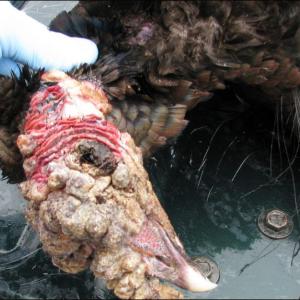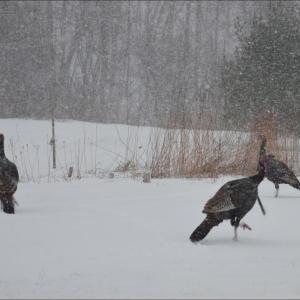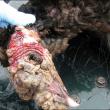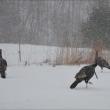New skin virus afflicts Maine turkeys
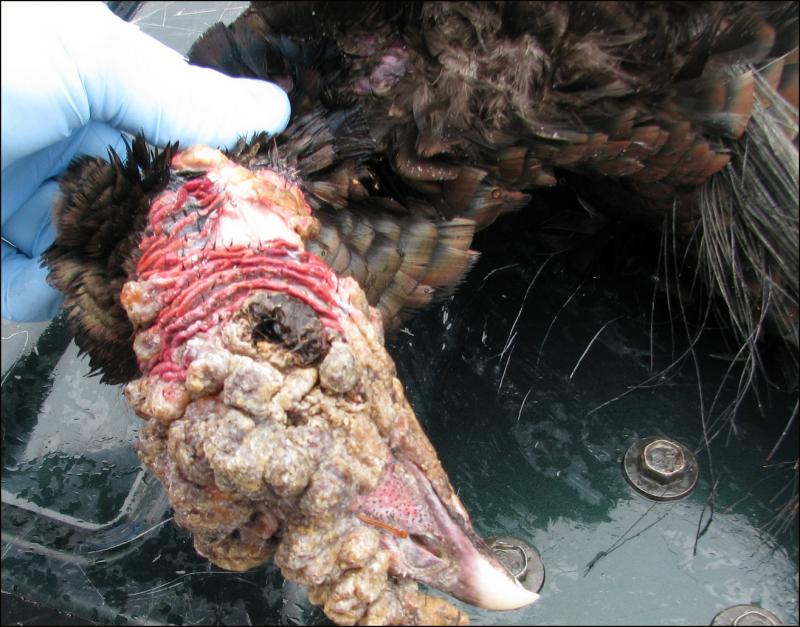 The Lymphoproliferative Disease Virus is afflicting Maine turkeys, and the state is warning hunters to be careful handling them, although sick turkeys are apparently still edible. (Photo courtesy Maine Department of Inland Fisheries and Wildlife)
The Lymphoproliferative Disease Virus is afflicting Maine turkeys, and the state is warning hunters to be careful handling them, although sick turkeys are apparently still edible. (Photo courtesy Maine Department of Inland Fisheries and Wildlife)
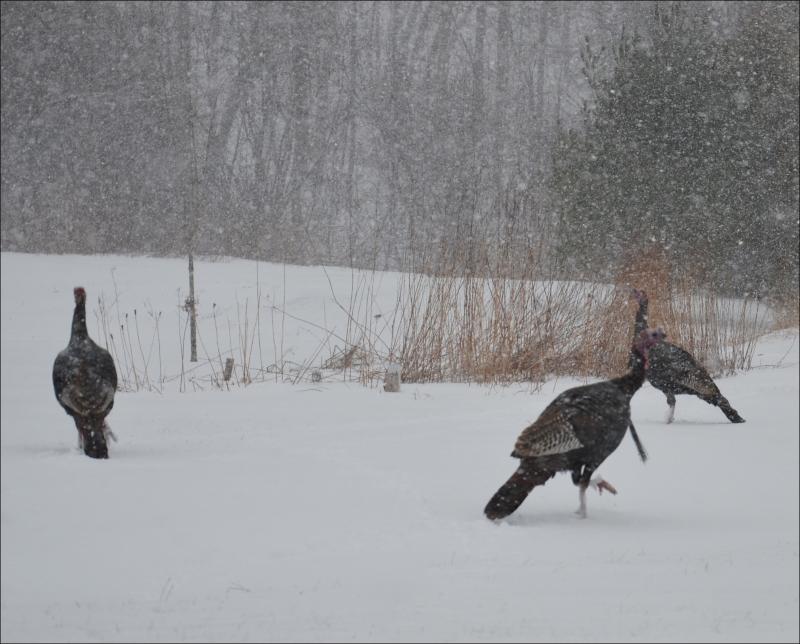 Wild turkeys on the side of Route 90 in Rockport, in March. (Photo by Lynda Clancy)
Wild turkeys on the side of Route 90 in Rockport, in March. (Photo by Lynda Clancy)
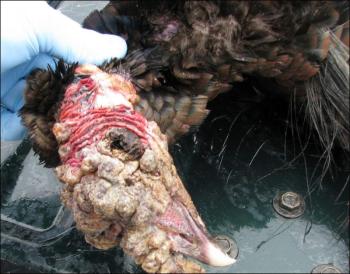 The Lymphoproliferative Disease Virus is afflicting Maine turkeys, and the state is warning hunters to be careful handling them, although sick turkeys are apparently still edible. (Photo courtesy Maine Department of Inland Fisheries and Wildlife)
The Lymphoproliferative Disease Virus is afflicting Maine turkeys, and the state is warning hunters to be careful handling them, although sick turkeys are apparently still edible. (Photo courtesy Maine Department of Inland Fisheries and Wildlife)
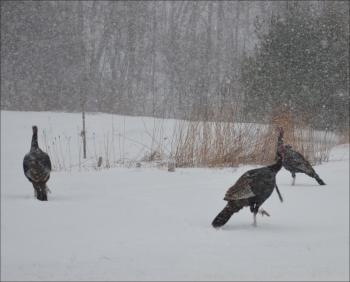 Wild turkeys on the side of Route 90 in Rockport, in March. (Photo by Lynda Clancy)
Wild turkeys on the side of Route 90 in Rockport, in March. (Photo by Lynda Clancy)
Mosquitos and direct skin contact is presenting a potentially deadly virus among turkey fowl, and Maine's Department of Inland Fisheries and Wildlife is warning hunters about secondary bacterial infections if the birds are improperly handled. Turkey hunting season opens Saturday and runs through May.
"The ramifications aren't nearly as bad as it looks," said Doug Rafferty, Director of Public Information and Education at Maine's IF&W. "It is more of a disfigurative virus. But it is something we want to keep our eye on this year."
The virus is not rampant; however, IF&W wants to monitor its progression through the state, Rafferty said. The agency is asking hunters to call the Department of Public Safety in Augusta, 800-452-4664 to be connected with a game warden.
Last year, there were 15,000 turkey hunters registered in Maine. They hunt throughout the state in the spring, which is the breeding season for the Eastern Wild Turkey. Rafferty said there are an estimated 60,000 wild turkeys in the woods of Maine.
The Lymphoproliferative Disease Virus (LPDV) was first recognized in a Maine turkey in April 2012. IF&W said there have been several confirmed cases of the virus in the state, the first detected in Gorham. The virus is thought to have originated in domestically-raised turkeys in Europe. The first confirmed case in the U.S. was in wild turkeys in Georgia in 2009, according to IF&W. The virus produces minor or extreme lesions on turkey heads and legs. Sometimes, turkeys will survive with minor infections; others will succumb to extreme lesions, losing their eyesight and ability to eat.
"Currently, known cases occur virtually wherever wild turkeys are present," said IF&W, in a press release circulated April 23. "We speculate that a combination of a very good turkey production year in 2011 and the mild winter of 2011-2012 may have contributed to the apparent increase in occurrence, recently. It is likely to be encountered in 2013, as well."
Eastern Wild Turkeys, which have increased in population over the last decade as Maine's forests regrow following centuries of clearcutting and farming, live in tracts of hardwood. They like nut-producing trees, such as oak and beech, and they also thrive in grassy areas.
While the virus made its first U.S. appearance in Georgia turkeys in 2009, it traveled north in three years.
"It got up here rather quickly, but then again, given the population and the way that people move around, it's not surprising," said Rafferty. "I could be hunting here one day and Georgia the next, and it wouldn't take much to spread the virus."
He said while humans are not affected by the virus, it is not known how it is spread.
"It's still pretty new," Rafferty said.
Although wild turkeys cannot pass this virus on to humans, if a hunter shoots a bird that looks like the above photograph and does not want to eat it, IF&W is asking that hunter to not register the bird and to contact a wildlife biologist. Or, hunters are asked to call the Department of Public Safety in Augusta, 800-452-4664, to be connected with a game warden. After examining the bird, the department staff member will determine a hunter's eligibility to harvest another turkey.
And if hunters decide to eat a diseased turkey, IF&W advises: "The disease poses no risk to human health. However, like all infections, caution is advised while handling a bird with LPDV. There is a potential for secondary bacterial infections if birds are handled improperly. Thoroughly cooking the meat to an internal temperature of a minimum of 165°F is also advised."
"Turkey hunting is very popular, and the way they are proliferating, people like to eat them," said Rafferty. "We had a wild game dinner Saturday and the turkey breast of the turkey I shot last fall was delicious. Turkey is pretty good eating. It's a different flavor but it's pretty good eating."
Hunters encountering turkeys with lesions are asked to contact one of the IF&W offices listed here:
Bangor – (207) 941-4466
Enfield – (207) 732-4132
Gray – (207) 657-2345
Greenville – (207) 695-3756
Jonesboro – (207) 434-5927
Sidney – (207) 547-5318
Strong – (207) 778-3324
About Wild Eastern Turkeys
Courtesy of Maine Inland Fisheries and Wildlife
Food habits. Turkeys feed on a wide variety of animal and plant materials such as insects, greens, fruits, berries, seeds, grains, and nuts. During winter, turkeys feed on bayberry fruits, sensitive fern spore heads, burdock seeds and other vegetation around spring-fed brooks and on bare edges of fields. In Maine, turkeys also depend on dairy farms for food to survive winter. Dairy farms provide silage corn and manure containing undigested corn that is either spread on fields or stockpiled for future spreading.
Reproduction. Wild Turkeys in Maine breed during April and May. Dominant toms do most of the breeding. Through elaborate strutting and gobbling, they try to attract and mate with as many hens as they can, which may be as many as 12 or more. After breeding, hens confine themselves to nesting. They construct nests in shallow depressions on the ground at the base of a tree or stump, under a tangle of brush, or in dense herbaceous cover. One egg is laid each day for up to ten to twelve days. Eggs are incubated by the hen from 26 to 28 days before hatching. If left unguarded, eggs are vulnerable to predators such as crows, skunks, raccoons, and red squirrels, and incubating hens can fall prey to dogs, coyotes, foxes, raccoons, bobcats, fisher, and great horned owls. Poults usually leave the nest the day they are hatched. Hens and their broods frequent field edges and forest openings in search of insects, which provide protein poults need for rapid growth during their early development. After 5-6 weeks of age, young turkeys begin roosting in trees, thus greatly reducing their vulnerability to predators.
Longevity. Mortality is greatest and most variable in the early stages of life. Once Wild Turkeys reach adulthood, they may live as long as 10 years.
Movements. Hens and their poults join other poults and hens to form flocks of 6 - 25 birds (occasionally up to 50 birds) during late summer, fall, and winter. Adult toms generally remain loners, but small groups of 2 to 5 toms of mixed ages are commonly seen throughout the year except breeding season. Feeding turkeys can cover several miles in a day.
Population and distribution trends. Historically, wild turkeys existed in significant numbers in York and Cumberland counties, and perhaps in lower numbers eastward to Hancock County. From the time of settlement until 1880, agricultural practices intensified until farmland comprised about 90 percent of York and Cumberland counties. The reduction in forest land and unrestricted hunting are believed to be the two most important factors leading to the extirpation of native wild turkeys in Maine in the early 1800s. Since 1880, many farms have been abandoned and the land has reverted back to forest. By 1970, only 15 percxenent of York and Cumberland Counties remained farmland. This reversion of thousands of acres of farmland to wooded habitat greatly enhanced prospects for reestablishing turkeys into their former range.
Editorial Director Lynda Clancy can be reached at lyndaclancy@penbaypilot.com; 706-6657.
Event Date
Address
United States

